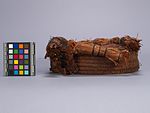łagakwame' (Head Ring)
About this object
History of use
Worn by Hamat’sa initiates. The initiate’s dance is considered by Kwakwaka’wakw people today to be the highest ranked ritual in the T’seka, or Red Cedar-Bark ceremony. It came to the Kwakwaka’wakw historically through marriage and warfare with their northern neighbours, the Wuikinuxv and the Heiltsuk. There are many differences in the way that families who have hereditary rights to this important privilege perform the dance, and in the songs and regalia they use, but common to all is the dramatic interpretation of the initiate’s experience of capture, return, and calming. In the dance of the Hamat’sa, a young person is possessed by the man-eating spirit, Baxbakwalanuksiwe’. Through the four stages of the dance the initiate is gradually returned to a normal, human state with the help of attendants, and through song and ritual. The cedar-bark regalia the initiate wears during this cycle is considered sacred.
Physical description
Base consists of a thin wide strip of bark overlaid with seven horizontally laid wood strips. These are bound on alternative diagonal angles with a wrap of thin twisted cedar bark string. Four bundles of cedar bark are sewn onto the top edge of the ring (spaced evenly). An extra piece of bark is sewn onto one side. The inside of the ring is lined with cotton cloth.
Categories
Materials
